Welcome to the nutritional density value in 6 different types of sea bass, ranging from 16.00 to 15.00 (out of a maximum of 100) per 100 Calories (kCal). The basic amount from the general description of sea bass is Fish, bass, striped, raw. The nutritional density score (out of 100) or nutritional value of Fish, bass, striped, raw is 15.00.
Top five sea bass products high in nutritional value
Below is a summary list for the top five sea bass items ranked by the amount or level of nutritional value in 100g. At the bottom of the page is the full list for the 6 different types of sea bass based on the content in different servings in grams and oz (and other serving sizes).1. Fish, bass, fresh water, mixed species, raw : 16.00%
2. Fish, bass, striped, raw : 15.00%
3. Fish, sea bass, mixed species, raw : 16.00%
4. Fish, sea bass, mixed species, cooked, dry heat : 15.00%
5. Fish, bass, freshwater, mixed species, cooked, dry heat : 16.00%
Following on from the five top sea bass items or products containing nutritional value we have a more comprehensive break down of Fish, bass, striped, raw, and the highest item containing nutritional value which is Fish, bass, fresh water, mixed species, raw. Furthermore we provide a comparison of average values, median values and lowest values along with a comparison with other food groups and assess the effects of storage and preparation on sea bass. Our aim is to provide a comprehensive analysis of the nutritional value content in sea bass.
Nutritional Density Values
The list at thee bottom of the page gives the total nutritional score in the 6 items from the general description 'sea bass' each of which show the nutritional amounts as well as Energy, Protein, Total Fat, Carbohydrate, Fiber and The top 6 food items are shown in the graph below, to give a quick and easy dietary comparison for the different items, where each item is listed at the bottom of the page with a nutritional summary.
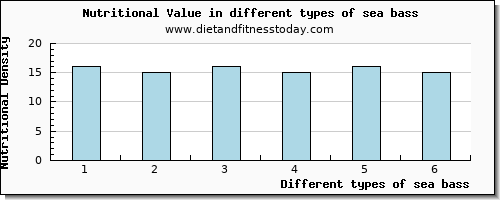
The level of nutritional value can be affected by the method of storage for example canned or frozen and also by the method of preparation for example either raw, cooked or fried. The total food items which are raw is 3 items. The highest amount of nutritional value from the 3 raw items is in Fish, bass, fresh water, mixed species, raw where the nutritional content score is 16.00. The number of food items which are cooked are 3 items. The highest amount of nutritional value from the 3 cooked items is in Fish, sea bass, mixed species, cooked, dry heat where the score is 15.00. Comparing raw and cooked sea bass shows that cooking can change the levels of nutritional value by 1.
For a serving per 100g, in a diet, the amount of Energy is 97.00 kcal (5% RDA), the amount of Protein is 17.73 g (32% RDA), the amount of Total Fat is 2.33 g (4% RDA), the amount of Carbohydrate is 0.00 g, the amount of Fiber is 0.00 g and The nutritional value amounts and nutrition facts for 100g is shown in the bar chart below as percentages of the recommended daily allowance.
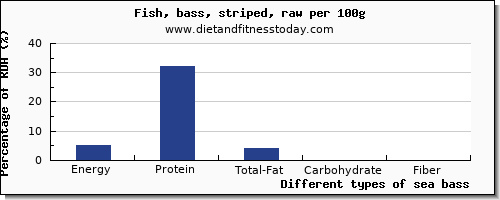
For the food Fish, bass, striped, raw the typical serving size is 3.000 oz (or 85.00 g). In terms of the gram weight and total content for this serving the Energy content is 82.45 kcal, the Protein content is 15.07 g, the Total Fat content is 1.98 g, the Carbohydrate content is 0 g, the Fiber content is 0 g and 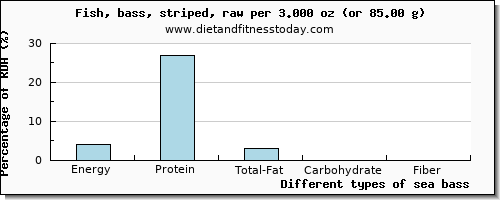
The amount of protein, fat and carbs from this food is measured as a gram weight value although it is also useful to give the calories from these macronutrients. For this serving in your diet here are the macronutrient calories. From protein the number of calories is 64.3 (kcal).The total calories from carbohydrate is 0.0 (kcal).
This list of 6 types of sea bass, is brought to you by www.dietandfitnesstoday.com and ranges from Fish, bass, fresh water, mixed species, raw through to Fish, bass, striped, cooked, dry heat where all food items are ranked by the nutritional value. The nutritional content can be scaled by the amount in grams, oz or typical serving sizes. Simply click on a food item or beverage from the list at the bottom of the page to give a full dietary nutritional breakdown to answer the question what is the nutritional value of sea bass.
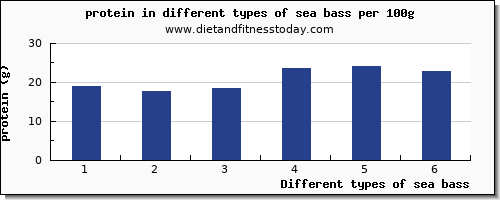
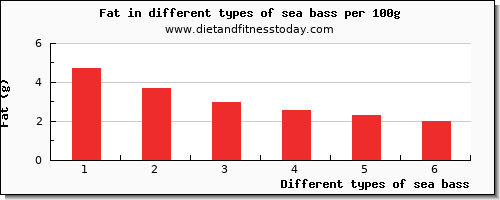
Average Content for sea bass
The average (or more correctly the arithmetic mean) amount of nutritional value contained in 100 Calories of sea bass, based on the list below of 6 different items under the general description of sea bass, is 15.50 % of nutritional value. The averages for the different nutrients are as follows; the average amount of Energy is 117.00 kcal, the average amount of Protein is 20.93 g, the average amount of Total Fat is 3.05 g, the average amount of Carbohydrate is 0.00 g, the average amount of Fiber is 0.00 g and the average amount of Sugars is 0.00 g.Median Amount
The median nutritional Nutrition Density value is found in Fish, sea bass, mixed species, raw which in 100 Calories contains 16.00 % of Nutrition Density. For this serving the amount of Energy is 97.00 kcal, the amount of Protein is 18.43 g, the amount of Total Fat is 2.00 g, the amount of Carbohydrate is 0.00 g, the amount of Fiber is 0.00 g and the amount of Sugars is 0.00 g.
Highest Nutritional Density Content
Using the list below for the 6 different sea bass nutrition entries in our database, the highest amount of nutritional value is found in Fish, bass, fresh water, mixed species, raw which has a nutritional value of 16.00. For a 100g serving the Energy content is 114.00 kcal, the Protein content is 18.86 g, the Total Fat content is 3.69 g, the Carbohydrate content is 0.00 g, the Fiber content is 0.00 g,
The lowest nutritional value is in Fish, bass, striped, cooked, dry heat which has a value of 15.00 % of nutritional value. For a 100g serving the amount of Energy is 124.00 kcal, the amount of Protein is 22.73 g, the amount of Total Fat is 2.99 g, the amount of Carbohydrate is 0.00 g, the amount of Fiber is 0.00 g, the amount of Sugars is 0.00 g.
The difference between the highest and lowest values gives a nutritional value range of 1. The range for the other nutrients are as follows; 10 kcal for Energy, 3.87 g for Protein, 0.7 g for Total Fat, 0 g for Carbohydrate, 0 g for Fiber,
Nutritional Scores per Typical Serving
For a typical serving of 1.000 fillet (or 129.00 g) for Fish, sea bass, mixed species, raw the Energy content is 125.13 kcal, the Protein content is 23.77 g, the Total Fat content is 2.58 g, the Carbohydrate content is 0 g, the Fiber content is 0 g and the Sugars content is 0 g.Nutritional Information Summary
From the list below you can find a full nutrition facts breakdown for all foods containing nutritional value which can be scaled for different servings and quantities.
| |||||||||||||||||||||||||||||||||||||||||||||||||||||||||||||||||||||||||||||||||||||||||||||||||||||||||||||||||||||||||||||||||||||||||||||||||||||||||||||||||||||||||||||||||||||||||||||||||||||||||||||||||||||||||||||||||||||||||||||||||||||||||||||||||||||||||||||||||||||||||||||||||||||||||||||||||||||||||||||||||||||||||||||||||||||